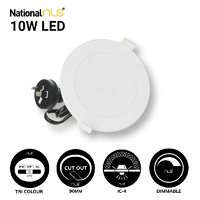
NLS 20111 | 10W Tri Colour LED Dimmable White Downlight 900lm | 90MM Hole
$8.25
$7.50 ex. GST
Search Results:
Search Results:
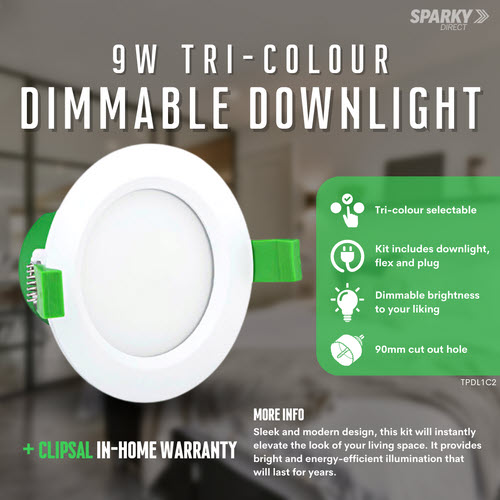
Learn all about the LED Downlights here at Sparky Direct [ Read More ]

NLS 20111 | 10W Tri Colour LED Dimmable White Downlight 900lm | 90MM Hole
$8.25
$7.50 ex. GST

SAL Wave S9065TCWH | 9W Tri Colour LED Dimmable White Downlight | 92MM Hole
$10.39
$9.45 ex. GST

NLS 20090TRI | 13W Tri Colour LED Dimmable White Downlight | 90MM Hole
Now $10.99
$9.99 ex. GST

Clipsal TPDL1C3 | 7W Tri-Colour Dimmable LED Down light Kit | 90mm Hole
$15.35
$13.95 ex. GST

Atom Lighting AT9039-WH-TRI | LED Recessed Downlight 8W TRI-CCT| Dimmable | White
$8.74
$7.95 ex. GST

ROBUS Taylor RC9WDLCCT4 | 9 Watt Dimmable All in One LED Downlight | 90MM Hole
$12.04
$10.95 ex. GST
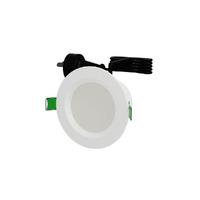
Clipsal TPDL1C3R | 7W Tri-Colour Dimmable LED Down light Kit | Ripple Resistant | 90mm Hole
Now $16.28
$14.80 ex. GST

NLS 20096 | 15W Tri Colour LED Dimmable White Downlight | 90MM Hole
$18.64
$16.95 ex. GST
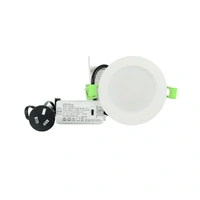
XLED XDA5 | Aura Shallow LED Tri Colour Downlight CCT Dimmable 9W | White | 90MM Hole
$9.85
$8.95 ex. GST

NLS 20111BLK | 10W Tri Colour LED Downlight Dimmable 950lm | Black Trim | 90MM Hole
$10.45
$9.50 ex. GST

7W Tri Colour LED Downlight | 70mm Cut Out | 3000, 4000, 6000K | Dimmable | NLS 20354
$9.35
$8.50 ex. GST
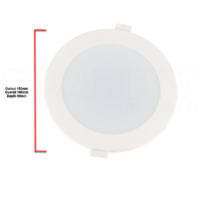
NLS 20405 | 20w Tri Colour LED Dimmable Downlight 1800-1900lm | 150mm Hole
$26.34
$23.95 ex. GST

LED downlights are energy-efficient recessed light fixtures using light-emitting diodes to provide bright, long-lasting illumination. They use 80% less energy than halogen, last up to 25,000 hours, and come in warm white, cool white, daylight, and tri-colour options. Available in dimmable models with various wattages and beam angles for Australian homes and businesses.
LED downlights are recessed ceiling fixtures that use semiconductors to convert electricity directly into light. This solid-state technology produces bright illumination with minimal heat and energy waste.
LED stands for Light Emitting Diode. When an electric current passes through the semiconductor material, it releases photons that create visible light. This process is far more efficient than traditional lighting methods that waste energy as heat.
Downlights are designed to be mounted in ceiling cavities with only the bezel visible from below. The recessed design creates a clean, modern look whilst directing light downward in a focused beam. Most models have a cut-out diameter between 70-90mm, fitting standard ceiling joists.
The LED chip produces light when electrons move through the semiconductor material. This electroluminescence creates photons without burning filaments or heating gases. The driver circuit converts mains voltage to a low DC voltage suitable for the LED, whilst heat sinks dissipate heat to maintain optimal operating temperature.
LED downlights use 80% less energy than halogen, last 12 times longer, run cooler, require less maintenance, and save hundreds of dollars annually on electricity bills.
A 10W LED produces the same light as a 50W halogen. For a home with 20 downlights running 5 hours daily, switching saves approximately $300 per year on electricity. LEDs convert 95% of their energy to light, compared with only 20% for halogen.
LED downlights last 25,000 hours compared to 2,000 hours for halogen. This means 12+ years of typical use without replacement. Fewer replacements mean lower maintenance costs and less ladder work, particularly valuable for high ceilings.
LEDs operate at significantly lower temperatures than halogen bulbs. This reduces fire risk, allows safe installation in insulated ceilings, prevents heat damage to surroundings, and improves summer comfort by reducing ceiling heat.
LEDs reach full brightness immediately when switched on. No warm-up period means instant illumination when entering rooms. This also makes them compatible with motion sensors and smart home systems.
Most modern LED downlights are dimmable when paired with compatible dimmers. This allows mood adjustment, further energy savings, and extended lifespan. Smooth dimming from 100% down to 5-10% is typical.
LEDs contain no mercury or hazardous materials. Lower energy consumption reduces carbon emissions. Longer lifespan means less waste. Many components are recyclable at the end of life.
| Factor | LED Downlight | Halogen Downlight |
|---|---|---|
| Typical Wattage | 10W | 50W |
| Lifespan | 25,000 hours | 2,000 hours |
| Energy Use (5hrs/day) | 18kWh/year | 91kWh/year |
| Annual Electricity Cost | $6/year | $30/year |
| Replacements Needed | 1 over 12+ years | 12+ over the same period |
| Operating Temperature | 60-70°C | 300°C+ |
LED downlights come in fixed colour, tri-colour switchable, fixed beam, and adjustable gimbal styles. Each type suits different applications and installation requirements.
Most Versatile Option
Switch between warm white (3000K), cool white (4000K), and daylight (6000K) using the light switch. Perfect when you're unsure which colour temperature suits your space. Simply flick the switch rapidly to cycle colours.
Popular models: NLS 20111, Clipsal TPDL1C3, SAL S9065TCWH
2700K-3000K
Creates a cosy, relaxing atmosphere with a yellowish glow similar to that of a halogen. Best for living rooms, bedrooms, dining areas, and any space where comfort and warmth are priorities. Traditional choice for Australian homes.
4000K
Neutral white light that balances warmth and clarity. Suitable for kitchens, bathrooms, laundries, home offices, and general-purpose lighting. Most popular choice for modern Australian interiors.
5000K-6500K
Bright, crisp white light with a bluish tone. Ideal for task lighting, workshops, garages, retail displays, and commercial applications. Mimics natural daylight for maximum visibility and colour accuracy.
Standard Recessed
Light shines directly downward in a fixed direction. Most common and economical option. Suitable for general room lighting where adjustability isn't required. Lower profile than gimbal models.
Available in all colour temperatures and wattages
Directional Lighting
Light can be angled up to 30-40° in any direction. Perfect for highlighting artwork, architectural features, or creating accent lighting. Suitable for sloped ceilings or specific task lighting needs.
Ideal for galleries, retail, or feature walls
For new installations where colour preference is uncertain, tri-colour downlights offer maximum flexibility. Install them and test all three colours before choosing your favourite. For replacements matching existing lighting, select the same colour temperature. For task areas needing precise lighting direction, choose gimbal models.
Colour temperature is measured in Kelvin (K) and describes whether light appears warm yellow, neutral white, or cool blue. Lower numbers are warmer, higher numbers are cooler.
Colour temperature significantly affects the ambience and functionality of a room. The same room can feel cosy or clinical depending solely on the light colour. Understanding Kelvin ratings helps you create the right atmosphere for each space.
| Kelvin Range | Description | Best For | Atmosphere |
|---|---|---|---|
| 2700K | Extra Warm White | Bedrooms, lounges | Very cosy, intimate |
| 3000K | Warm White | Living areas, dining rooms | Relaxed, welcoming |
| 4000K | Cool White/Neutral | Kitchens, bathrooms, offices | Clean, balanced |
| 5000K | Daylight | Workshops, garages | Bright, energising |
| 6000K+ | Cool Daylight | Commercial, retail | Very bright, clinical |
Best for: Bedrooms, living rooms, dining areas
Why: Creates a relaxing atmosphere. Yellowish tone is familiar and comfortable. Reduces eye strain before bedtime. Makes spaces feel cosy and inviting.
Best for: Kitchens, bathrooms, home offices
Why: Neutral white suits task-focused areas. Enhances visibility without harsh glare. Modern, clean appearance. Most versatile option for Australian homes.
Best for: Garages, workshops, laundries
Why: Maximum visibility for detailed work. True colour representation. Mimics natural daylight. Energising effect improves focus and productivity.
Best for: Any room where you're unsure
Why: Test all three options after installation. Switch between colours as needs change. No need to reinstall if preferences evolve. Best value for new builds.
For open-plan living areas, use the same colour temperature throughout to avoid visual jarring. For a 4x4m bedroom, we recommend tri-colour models like the NLS 20111 (10W), Clipsal TPDL1C2 (9W), or SAL S9065TCWH (8W).
Understanding lumens, watts, CRI, and beam angle helps you choose downlights that deliver the right brightness, colour accuracy, and light coverage for each room.
| Room Type | Lumens per m² | Example (4x4m room) |
|---|---|---|
| Living Room | 100-150 lm/m² | 1,600-2,400 lumens total |
| Kitchen | 300-400 lm/m² | 4,800-6,400 lumens total |
| Bathroom | 200-300 lm/m² | 3,200-4,800 lumens total |
| Bedroom | 100-200 lm/m² | 1,600-3,200 lumens total |
| Office/Study | 300-500 lm/m² | 4,800-8,000 lumens total |
CRI measures how accurately colours appear under artificial light compared to natural sunlight (CRI 100). A downlight with CRI 80 shows colours fairly accurately. CRI 90+ is excellent for areas where colour accuracy matters—kitchens (food preparation), bathrooms (makeup application), wardrobes (clothing selection), and art displays. Most quality LED downlights from brands like NLS, Clipsal, and SAL offer CRI ratings of 80-85, which are suitable for general residential use.
Consider room size, ceiling height, purpose, and existing fittings. Calculate total lumens needed, select appropriate colour temperature, and choose dimmable options for flexibility.
Measure room length and width in metres. Multiply to get the area. Multiply area by required lumens per square metre (see table above). Divide total lumens by individual downlight output to determine the quantity needed.
Example: 4m x 5m kitchen = 20m². Need 300lm/m² = 6,000 lumens total. Using 900lm downlights = 6,000 ÷ 900 = 7 downlights needed.
Choose based on the room function. Warm white (3000K) for living areas, cool white (4000K) for kitchens and bathrooms, daylight (5000K+) for workshops. When unsure, select tri-colour for maximum flexibility.
Tip: Maintain consistent colour temperature in open-plan areas to avoid visual conflict.
Measure existing cut-out holes if replacing. Verify ceiling cavity depth (typically requires 100 mm+). Check for insulation—if present, ensure downlights are IC-F rated. Determine if bathroom zones require an IP44 or an IP65 rating.
Important: Use adaptor plates if new downlights have a smaller cut-out than the existing holes.
Dimmable downlights offer flexibility to adjust brightness for different activities and times of day. Ensure dimmer switches are LED-compatible (trailing-edge type). Check the manufacturer's specifications for the minimum dimming level.
Note: Most modern downlights dim smoothly from 100% to 5-10%.
Select reputable brands with good warranty coverage. Look for Australian approval marks. Consider brands with proven track record: NLS (excellent value), Clipsal (premium quality), SAL (good all-rounder), Atom, XLED, Robus.
Warranty: Most quality downlights offer a 2-5 year warranty.
For general room lighting, space downlights evenly throughout the ceiling. Typical spacing: 1.2-1.5m apart for standard 2.4m ceilings. For higher ceilings, increase the spacing slightly or use higher-wattage downlights. Avoid placing downlights too close to walls—maintain 50-70cm clearance from walls to prevent harsh shadows and glare.
All permanent electrical work in Australia must be performed by licensed electricians complying with AS/NZS 3000:2018. Installation typically takes 15-30 minutes per downlight, including wiring.
Licensed Electrician Required: All mains voltage electrical work in Australia must be performed by licensed electricians in compliance with AS/NZS 3000:2018.
Safety Switch Protection: Circuits must be protected by RCDs (safety switches) as per the Australian Wiring Rules.
Testing: After installation, electricians must verify correct polarity, earth continuity, insulation resistance, and circuit operation before energising.
LED downlights suit any room requiring clean, modern lighting. From residential living areas to commercial spaces, their versatility, efficiency, and slim profile make them ideal for Australian homes and businesses.
Recommendation: Warm white (3000K) or tri-colour dimmable
Create a relaxing atmosphere for family time. Use dimmers to adjust brightness for movie nights. Space 1.2-1.5m apart. 100-150 lumens per m² is sufficient for ambient lighting.
Recommendation: Cool white (4000K), 300-400 lm/m²
Bright, clear lighting for food preparation and cooking. Consider extra downlights over benchtops and islands. High CRI (80+) is important for accurate food colour.
Recommendation: Cool white (4000K), IP44+ rated
Use IP44-rated downlights in zones 2-3. IP65 for shower areas. Cool white provides clarity for grooming tasks. 200-300 lumens per m² recommended.
Recommendation: Warm white (3000K) dimmable
Soft, relaxing light promotes better sleep. Dimming capability allows adjustment from bright (dressing) to low (pre-sleep). 100-200 lumens per m² is sufficient.
Recommendation: Cool white (4000K), 300-500 lm/m²
Bright, focused lighting reduces eye strain during computer work. Cool white promotes alertness and concentration. Consider additional task lighting for desks.
Recommendation: Cool white (4000K), motion sensors
Install motion sensors for automatic activation. Two-way switches for long hallways. Space closer together in narrow passages to prevent dark spots.
Recommendation: Daylight (5000K+), high output
Maximum brightness for detailed work. True colour rendering for accurate material identification. Consider 13W models for larger workshops.
Recommendation: IP65 rated, warm or cool white
Weather-resistant IP65 downlights for outdoor entertaining areas. Warm white creates an inviting atmosphere. Ensure suitable for the intended climate conditions.
High CRI (90+) downlights show merchandise in true colours. Adjustable gimbal models highlight featured products. Cool white maintains energy and encourages browsing.
Uniform lighting reduces screen glare and eye strain. Cool white (4000K) promotes productivity. Dimmable systems integrate with daylight harvesting for energy efficiency.
Warm white creates a welcoming atmosphere in restaurants and hotels. Dimmable downlights adjust ambience from energetic (breakfast) to intimate (dinner service).
High CRI and cool white light are essential for medical facilities. Flicker-free operation prevents discomfort during examinations. Easy cleaning and maintenance reduce the risk of infection.
Specs: 900lm, tri-colour, dimmable, 90mm cut-out
Why Choose: Exceptional value. Tens of thousands sold. Reliable performance. Perfect for whole-home installations. View Details →
Specs: 700lm, tri-colour, dimmable, 90mm cut-out
Why Choose: Premium Clipsal quality. In-house warranty. Thousands sold. Trusted brand for quality-conscious buyers. View Details →
Specs: 800lm, tri-colour, dimmable, 92mm cut-out
Why Choose: Good all-rounder. Reliable SAL brand. Competitive pricing. Suitable for most residential applications. View Details →
Specs: 1170lm, tri-colour, dimmable, 90mm cut-out
Why Choose: Higher output for larger rooms or higher ceilings. Bright illumination with excellent efficiency. View Details →
Unsure Which Model to Choose? Our expert team can recommend the perfect downlights for your project based on room size, ceiling height, and lighting requirements. Contact us for personalised advice.
Get Expert Advice →Australia's trusted trade supplier • Expert advice • Fast nationwide delivery • Competitive trade pricing
Browse All Downlights → View Tri-Colour Range →There are two main types of LED downlights: recessed and surface mounted. Recessed downlights are installed into the ceiling, while surface-mounted downlights are mounted on the surface of the ceiling.
Installing LED downlights can be a DIY project if the downlight has a 3-pin plug and a surface socket is already installed. If there is no surface socket installed, you must hire a professional electrician to do it for you.

Hey there, got a question? Ask Dan & Lee now 😁👍